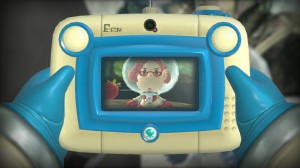[E3 Impressions] A Surprise Hiding in Plain Sight: Pikmin 3

A fan of the first game and aware of the first two iterations’ critical acclaim, I had pretty decently high hopes for the third in the trilogy given the graphically impressive trailers released for the game on previous Nintendo Directs, but playing it in person was a whole ‘nother story. While many might know of Wiimote control’s efficacy in the series due to the New Play iterations released for Wii a few years ago, it was my first time utilizing such a scheme, and boy was it smooth. For those unaware, players control movement of the mysterious alien overlord (formerly Captain Olimar) and his or her “Pikmin” (small alien creatures) with the control stick. ‘A’ will launch selected Pikmin towards a specific task—defeating a bugged enemy, collecting fruits, building or clearing obstructions–, whilst pressing ‘B’ will, in a manner akin to a traditional control, alert all nearby Pikmin within a surrounding radius to join your cause. Manage sole control of varying Pikmin types—sending only blue ones to complete underwater missions, for example, or red ones in fire-lit thickets—by toggling with ‘C’.
The feature I loved most about the control scheme that “New Play control” introduced was the lock-on method of execution. Lock-on to a target– say, a bridge to build– with ‘Z’ (as you have since Ocarina of Time) and simply nudge the Nunchuk forward to send all selected Pikmin types at something. It’s a very simple and efficient method of control that allows streamlinity in gameplay for experienced gamers wishing to get a move on. In addition, as someone who generally prefers dual analog control, IR pointer control genuinely stamps out its predecessor in easy fashion, outmaneuvering it in spades. Fret not, however, fans of dual analog, for Nintendo still allows the option to use the GamePad to control things in off-TV mode.
While I thought stylus control on the GamePad would be a no-brainer, implied inclusion in this Wii U iteration of the series, Nintendo, for better or worse, decided not to implement it. I still intuitively feel it has potential in the series, but am too pleased with how wonderful Wiimote+Nunchuk control is to pine at all for it.

In addition to the “new” control scheme improving things, gameplay in Pikmin 3 in comparison to its predecessors was truly advanced by the inclusion of two new Pikmin types: black, onyx-y, polygonal “rock” Pikmin, and purple “flying” Pikmin. The former acts as a unit specializing in clearing out obstacles and combat, its weaknesses lying in speed, while the latter can reach high-up things to carry back to the ship and skirt by obstacles easily, its weakness lying in combat and the fact that ground Pikmin moving in a straight line outspeed them whilst carrying goods.
While the introduction of new-yet-familiar gameplay retreads in a manner that usually ends up being superfluous, I did not find that to be the case in the slightest for Pikmin 3. Gameplay was enhanced to an extreme, almost uncharacteristic level for first party Nintendo titles level of complication, but not once did it feel overwhelming; it feels like the “whole” that the previous iterations were striving to achieve. Fans of meticulous strategic lines of play from real-time strategy games such as Starcraft or Warcraft III will rejoice with Pikmin 3, as discovering superior lines of play definitely lead to heightened utility for me, albeit truncated due to the ten-minute time limit the demo offered.

In addition to the gameplay boons the new Pikmin add to Pikmin 3, side-missions separate from the main game (the main game being something I couldn’t play, unfortunately, though I wholeheartedly assume it will be grand) will legitimately pique the interest of said RTS aficionados while adding immense, not-tacked-on-in-the-slightest replay value as well; objectives will generally be time or points-based.
In an unexpected move, Pikmin 3 will feature those missions playable with a friend or acquaintance in two-player split-screen multiplayer, adding the strategic dimension of teamwork as well. This surprising addition is truly exemplary of the underlying feeling of integrity emblazoned upon Pikmin 3 from all fronts, the antithesis of what I feel of concerning the new Mario 3D Land sequel. After each mission, the game will even replay it on the map on the GamePad from bird’s-eye view, letting you note places you could improve on in the future.
Ending a writing piece with out-of-place, slightly off-topic aesthetics coverage is commonplace amongst my work, and boy let me tell you, this game is gorgeous. Being a big fan of the Gamecube’s visual ethos, I was frightened, as I was for Wind Waker and its soon-to-be released high-definition counterpart, that the HD iteration on Wii U would eschew the “unrehalistic” poppy brightness the original possessed, and go for a grainier, more “objectively real” look commonplace amongst Havok 3 engine games in the seventh generation. While I can say for sure the game isn’t as “simply bright” as the first, it’s a perfect natural progression onto a newer console that requires finer detail. It’s, in my mind, the best looking game yet on Wii U.
While Pikmin 3 still might be too attached to its genre to ever be a blockbuster, system-selling title, this iteration not only looks like the best in what is already an acclaimed and beloved series, but is, in my mind, the best title they had to offer at E3 2013. Pikmin 3 stands tall as an emblem that when Nintendo really and dearly tries, amazing things can happen (delays aside).

Try our Facebook page!
Or our Twitter page!